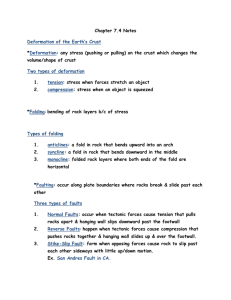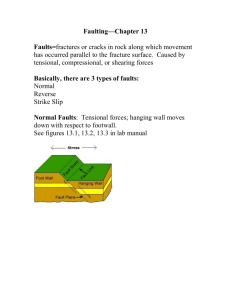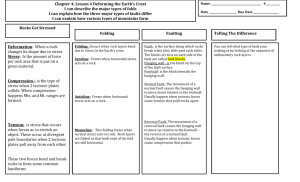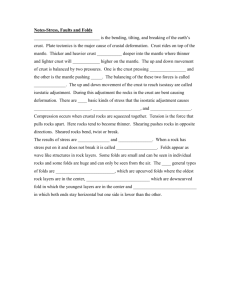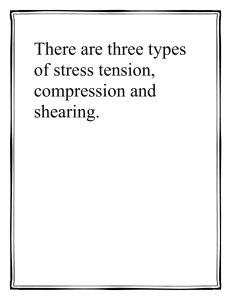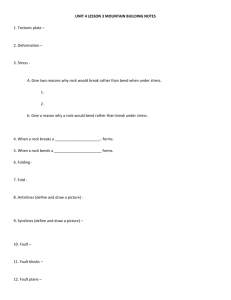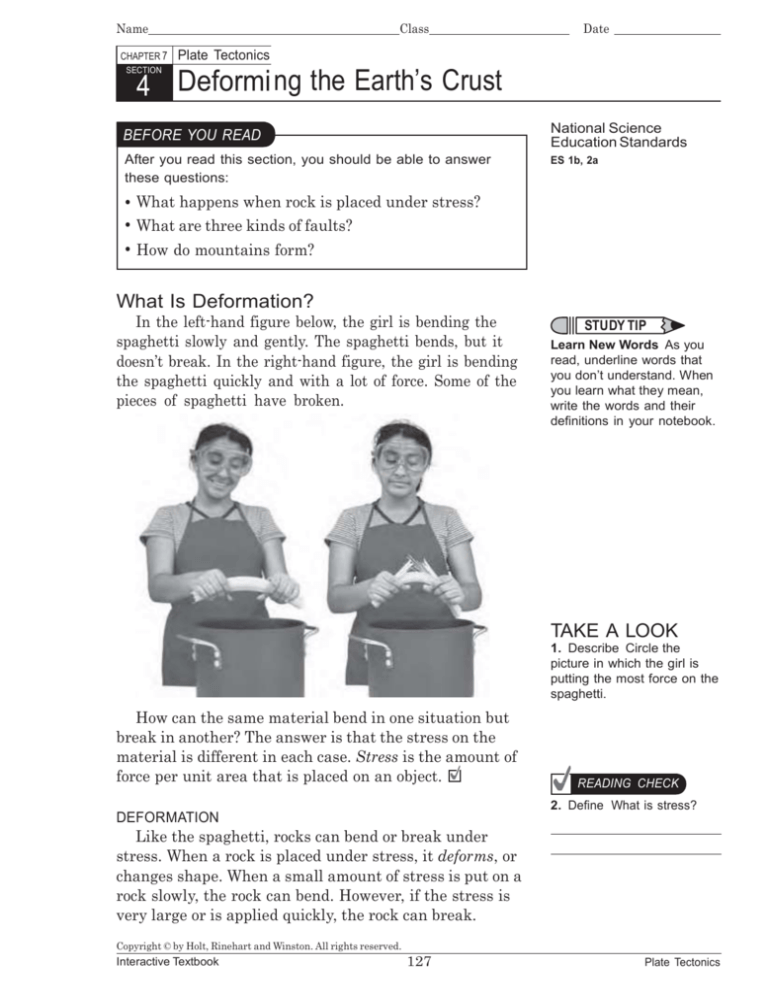
Name
CHAPTER 7
Class
Date
Plate Tectonics
4 Deformi ng the Earth’s Crust
SECTION
National Science
Education Standards
BEFORE YOU READ
After you read this section, you should be able to answer
these questions:
ES 1b, 2a
• What happens when rock is placed under stress?
• What are three kinds of faults?
• How do mountains form?
What Is Deformation?
In the left-hand figure below, the girl is bending the
spaghetti slowly and gently. The spaghetti bends, but it
doesn’t break. In the right-hand figure, the girl is bending
the spaghetti quickly and with a lot of force. Some of the
pieces of spaghetti have broken.
STUDY TIP
Learn New Words As you
read, underline words that
you don’t understand. When
you learn what they mean,
write the words and their
definitions in your notebook.
TAKE A LOOK
1. Describe Circle the
picture in which the girl is
putting the most force on the
spaghetti.
How can the same material bend in one situation but
break in another? The answer is that the stress on the
material is different in each case. Stress is the amount of
force per unit area that is placed on an object.
READING CHECK
2. Define What is stress?
DEFORMATION
Like the spaghetti, rocks can bend or break under
stress. When a rock is placed under stress, it deforms, or
changes shape. When a small amount of stress is put on a
rock slowly, the rock can bend. However, if the stress is
very large or is applied quickly, the rock can break.
Copyright © by Holt, Rinehart and Winston. All rights reserved.
Interactive Textbook
127
Plate Tectonics
Name
SECTION 4
Class
Date
Deforming the Earth’s Crust continued
What Happens When Rock Layers Bend?
READING CHECK
3. Explain How do folds
indicate that deformation has
happened?
Folding happens when rock layers bend under stress.
Folding causes rock layers to look bent or buckled. The
bends are called folds.
Most rock layers start out as horizontal layers.
Therefore, when scientists see a fold, they know that
deformation has happened.
TYPES OF FOLDS
Three of the most common types of folds are synclines, anticlines, and monoclines. In a syncline, the
oldest rocks are found on the outside of the fold. Most
synclines are U-shaped. In an anticline, the youngest
rocks are found on the outside of the fold. Most anticlines are n-shaped. In a monocline, rock layers are
folded so that both ends of the fold are horizontal. The
figure below shows these kinds of folds.
9OUNGER ROCK
9OUNGER ROCK
/LDER ROCK
/LDER ROCK
In a syncline, the youngest
rocks are on the inside of
the fold.
In an anticline, the oldest
rocks are on the inside of
the fold.
9OUNGER ROCK
TAKE A LOOK
/LDER ROCK
4. Identify Color the
oldest rock layers in the
figure blue. Color the
youngest rock layers red.
In a monocline, both sides of
the fold are horizontal.
What Happens When Rock Layers Break?
When rock is put under so much stress that it can no
longer bend, it may break. The crack that forms when
rocks break and move past each other is called a fault.
The blocks of rock that are on either side of the fault are
called fault blocks. When fault blocks move suddenly,
they can cause earthquakes.
Copyright © by Holt, Rinehart and Winston. All rights reserved.
Interactive Textbook
128
Plate Tectonics
Class
Name
SECTION 4
Date
Deforming the Earth’s Crust continued
HANGING WALL AND FOOTWALL
When a fault forms at an angle, one fault block is
called the hanging wall and the other is called the
footwall. The figure below shows the difference between
the hanging wall and the footwall.
Fault
Hanging wall
TAKE A LOOK
5. Compare How is the
hanging wall different from
the footwall?
Footwall
The footwall is the fault block that is below the fault. The hanging wall is
the fault block that is above the fault.
Scientists classify faults by how the fault blocks have
moved along the fault. There are three main kinds of
faults: normal faults, reverse faults, and strike-slip faults.
NORMAL FAULTS
In a normal fault, the hanging wall moves down, or
the footwall moves up, or both. Normal faults form when
rock is under tension. Tension is stress that pulls rock
apart. Therefore, normal faults are common along
divergent boundaries, where Earth’s crust stretches.
READING CHECK
6. Explain Why are normal
faults common along
divergent boundaries?
Normal faults
form when rocks
are pulled apart.
Copyright © by Holt, Rinehart and Winston. All rights reserved.
Interactive Textbook
129
Plate Tectonics
Class
Name
SECTION 4
Date
Deforming the Earth’s Crust continued
REVERSE FAULTS
In a reverse fault, the hanging wall moves up, or the
footwall moves down, or both. Reverse faults form when
rock is under compression. Compression is stress that
pushes rock together. Therefore, reverse faults are common at convergent boundaries, where plates collide.
TAKE A LOOK
7. Identify Label the
hanging walls and the
footwalls on the normal
and reverse faults.
Reverse faults form
when rocks are
pushed together.
STRIKE-SLIP FAULTS
In a strike-slip fault, the fault blocks move past each
other horizontally. Strike-slip faults form when rock is
under shear stress. Shear stress is stress that pushes different parts of the rock in different directions. Therefore,
strike-slip faults are common along transform boundaries, where tectonic plates slide past each other.
Strike-slip faults form
when rocks slide past
each other horizontally.
TAKE A LOOK
8. Describe How do
strike-slip faults form?
It can be easy to tell the difference between faults in
a diagram. However, faults in real rocks can be harder to
tell apart. The figure on the top of the next page shows an
example of a fault. You can probably see where the fault is.
How can you figure out what kind of fault it is? One way is
to look at the rock layers around the fault. The dark rock
layer in the hanging wall is lower than the same layer in
the footwall. Therefore, this is a normal fault.
Copyright © by Holt, Rinehart and Winston. All rights reserved.
Interactive Textbook
130
Plate Tectonics
Class
Name
SECTION 4
Date
Deforming the Earth’s Crust continued
Hanging wall
Footwall
TAKE A LOOK
9. Explain How can you tell
that this is a normal fault?
In these rocks, the hanging wall has moved down compared
to the footwall. Therefore, this is a normal fault.
How Do Mountains Form?
As tectonic plates move over Earth’s surface, the edges
of the plates grind against each other. This produces a lot
of stress in Earth’s lithosphere. Over very long periods of
time, the movements of the plates can form mountains.
Mountains can form in three main ways: through folding,
faulting, or volcanism.
FOLDED MOUNTAINS
Folded mountains form when rock layers are squeezed
together
and
pushed
upward.
Folded
mountains
usually
of millions of years ago
when North America
collided with Europe and
Africa.
FAULT-BLOCK MOUNTAINS
Critical Thinking
10. Apply Concepts Why
does it take a very long time
for most mountains to form?
form
READING CHECK
11. Identify What kind
of stress forms fault-block
mountains?
Fault-block mountains form when tension makes the
lithosphere break into many normal faults. Along these
faults, pieces of the lithosphere drop down compared with
other pieces. This produces fault-block mountains.
Fault-block mountains form when tension causes the crust to
break into normal faults.
Copyright © by Holt, Rinehart and Winston. All rights reserved.
Interactive Textbook
131
Plate Tectonics
Class
Name
SECTION 4
Date
Deforming the Earth’s Crust continued
VOLCANIC MOUNTAINS
Say It
Investigate Find out more
about a volcanic mountain
chain, such as the Andes, the
Hawaiian islands, or Japan.
Share what you learn with a
small group.
Volcanic mountains form when melted rock erupts
onto Earth’s surface. Most major volcanic mountains are
found at convergent boundaries.
3OUTH !MERI AN
PLATE
.AZ A
PLATE
The Andes mountains
are examples of volcanic
mountains. The Andes
have formed where the
Nazca plate is subducting
beneath the South American plate.
TAKE A LOOK
12. Identify What kind
of convergent boundary
have the Andes mountains
formed on?
Volcanic mountains can form on land or on the ocean
floor. Volcanoes on the ocean floor can grow so tall that
they rise above the surface of the ocean. These volcanoes
form islands, such as the Hawaiian Islands.
Most of Earth’s active volcanoes are concentrated
around the edge of the Pacific Ocean. This area is known
as the Ring of Fire.
Type of Mountain Description
TAKE A LOOK
13. Describe Fill in the table
with the features of each
kind of mountain. Include
where the mountains form
and what they are made of.
Folded
Fault-block
Volcanic
How Can Rocks Move Vertically?
There are two types of vertical movements in the crust:
uplift and subsidence. Uplift happens when parts of Earth’s
crust rise to higher elevations. Rocks that are uplifted may
or may not be deformed. Subsidence happens when parts
of the crust sink to lower elevations. Unlike some uplifted
rocks, rocks that subside do not deform.
Copyright © by Holt, Rinehart and Winston. All rights reserved.
Interactive Textbook
132
Plate Tectonics
Class
Name
SECTION 4
Date
Deforming the Earth’s Crust continued
CAUSES OF SUBSIDENCE AND UPLIFT
Temperature changes can cause uplift and subsidence.
Hot rocks are less dense than cold rocks with the same
composition. Therefore, as hot rocks cool, they may sink. If
cold rocks are heated, they may rise. For example, the crust
at mid-ocean ridges is hot. As it moves away from the ridge,
it cools and subsides. Old, cold crust far from a ridge has a
lower elevation than young, hot crust at the ridge.
#OOLING AND
SUBSIDENCE
#OOLING AND
SUBSIDENCE
-ID-OCEAN
RIDGE
TAKE A LOOK
14. Explain Why does ocean
crust far from a mid-ocean
ridge subside?
(EATING
AND UPLIFT
Changes in the weight on the crust can also cause
uplift or subsidence. For example, glaciers are huge,
heavy bodies of ice. When they form on the crust, they
can push the crust down and cause subsidence. If the glaciers melt, the weight on the crust decreases. The crust
slowly rises back to its original elevation in a process
called rebound.
7EIGHT OF
GLACIER
TAKE A LOOK
'LACIER
15. Identify What force
caused the crust to subside
in the left-hand figure?
#RUST
#RUST
-ANTLE
-ANTLE
5PLIFT
Fault-block mountains are an example of a third way
subsidence can happen. When the crust is under tension,
rocks are stretched. They can break and form normal
faults. The crust can sink along these faults, causing
subsidence. This kind of subsidence is common in rift
zones. A rift zone is a set of deep cracks that forms at a
divergent boundary.
Copyright © by Holt, Rinehart and Winston. All rights reserved.
Interactive Textbook
133
Plate Tectonics
Class
Name
Date
Section 4 Review
NSES
ES 1b, 2a
SECTION VOCABULARY
compression stress that occurs when forces act
to squeeze an object
fault a break in a body of rock along which one
block slides relative to another
folding the bending of rock layers due to stress
subsidence the sinking of regions of the Earth’s
crust to lower elevations
tension stress that occurs when forces act to
stretch an object
uplift the rising of regions of the Earth’s crust to
higher elevations
1. Compare How are folding and faulting similar? How are they different?
2. Describe Fill in the spaces in the table to describe the three main kinds of faults.
Kind of fault
Description
Kind of stress that
produces it
Normal
Hanging wall moves
up; footwall moves
down.
shear stress
3. Explain Why are strike-slip faults common at transform boundaries?
4. Infer Why are fault-block mountains probably uncommon at transform boundaries?
5. Define What is the Ring of Fire?
Copyright © by Holt, Rinehart and Winston. All rights reserved.
Interactive Textbook
134
Plate Tectonics

